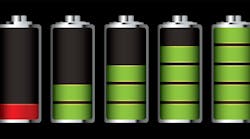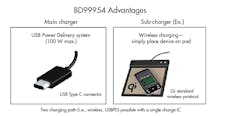A growing number of portable devices are adopting the USB Type-C Power Delivery (USBPD) standard that can charge up to 100W (20V/5A). To deliver the wide power supply range required by USBPD, a boost function must be added to a system to charge 2-cell (~8.4V) batteries from conventional 5V chargers. And if you want to enable the two different charging methods at the same time it further requires mounting charge ICs along with peripheral components as well as an MCU to control charge switching, all presenting a barrier to introduction.
But to show it can be done in a simpler manner while still supporting of the two predominant charging methods for the latest portable devices, ROHM has developed the BD99954, a Battery Management LSI for 1 to 4 cell Lithium-Ion secondary batteries and the first with dual-input control. Thus, it can autonomously select from two inputs-- which one to get the supply-- without intervention from an external controller, using instead an original built-in charging adapter function. Eliminating the MCU also removes the need to mount external peripheral components such as transistors and resistors typically necessary.
The BD99954 supports input voltages from 3.8V to 25V. This range encompasses the voltage range of 5V to 20V defined by USB PD (USB Power Delivery). Additionally, it also natively supports BC 1.2 (Battery Charging Specification v1.2) detection. This provides support for legacy USB AC Adaptors. The device does not natively support wireless charging but a wireless charging device can be connected to one of the inputs in order for the system to support wireless charging.
Rohm’s dual-mode battery charger supports input voltages from 3.8V to 25V.
BD99954 also integrates a charging profile that monitors the charging state of the battery and limits the maximum current provided to the battery. This feature prevents the part from providing too much current to the battery, possibly damaging it. In addition, it can also monitor the temperature of the battery to reduce the charging current when the battery overheats.
BD99954GW is available in a 0.4mm pitch, 2.6mm x 3.0mm x 0.62mm wafer level CSP package designed for space-constraint equipment such as low-profile notebook PCs, tablets, and other applications. BD99954MWV comes in a 0.4mm pitch, 5.0mm x 5.0mm x 1.0mm QFN package. OEM quantities will be available this month.
To assist engineers ROHM also has introduced an evaluation kit for the BD99954 battery management system. Designated BD99954MWV-EVK-101 and featuring a GUI, users can access the battery charging profile and modify and read back the registers of the device.
The BD99954MWV EVK acts as a platform for the BD99954 battery management LSI. With the included software GUI, users can access the battery charging profile and modify and read back the registers of the BD99954.
The BD99954MWV EVK-101 board comes with a bill of materials, schematics, board layout, and application data. It features a Reverse Buck/Boost Option and an On-Board USB-to-I2C Communication Circuit. Its Input Operating Range is 3.8V to 25V. In addition, a user manual for the I2C control software is included to help program the BD99954MWV.
Operation is straightforward: make sure the BD99954 board is connected to your PC via USB cable and is powered on with a power supply. Once connected, click on the BD99954 I2C Control icon located on the desktop GUI or find the application in the Windows Start Menu to start the program. Upon starting the program and BD99954 board is being powered up with the appropriate voltage, the software will indicate on the top-right corner if the board is connected.



